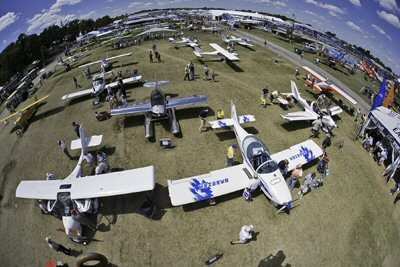Mon, Jul 06, 2009
FAA Began The Light Sport Aircraft And Sport Pilot Programs In
2004
 The idea was to make it so that more people could experience
flying from the front of the airplane, rather than the back. And
according to the FAA, more than 2,000 people have earned Sport
Pilot licenses since the program began in 2004. Aircraft
manufacturers have come up with more than 90 LSA designs, and there
are more than 800 factory-built Special Light Sport Aircraft
recognized by the administration. Many have such features as
whole-airplane parachutes, airbags, and avionics that can stabilize
the aircraft at the touch of a button.
The idea was to make it so that more people could experience
flying from the front of the airplane, rather than the back. And
according to the FAA, more than 2,000 people have earned Sport
Pilot licenses since the program began in 2004. Aircraft
manufacturers have come up with more than 90 LSA designs, and there
are more than 800 factory-built Special Light Sport Aircraft
recognized by the administration. Many have such features as
whole-airplane parachutes, airbags, and avionics that can stabilize
the aircraft at the touch of a button.
The FAA Publication Aviation News reports that a primary reason
for the rapid growth in the LSA segment of the industry is
engineering standards adopted by FAA for the airplanes. It’s
important to understand, they say, that the industry has been asked
to take more direct responsibility for developing and maintaining
standards for design, manufacturing, and continued airworthiness.
However, the American Society for Testing Materials(ASTM) standards
that are critical to LSA development are not written by the FAA,
but accepted by them and published in the federal register. Several
FAA employees sit on the ASTM committee that designs the standards,
but it is an industry function, not one of the government. That can
make for a more nimble process in adjusting standards as conditions
warrant. The FAA says the standards are not regulations, but
manufactures must adhere to the standards and are responsible for
monitoring and correcting safety issues, and the owner or operator
of an SLSA must comply with each safety directive applicable to the
aircraft, unless he or she finds an acceptable alternative, or
obtains an FAA waiver.

Safety is, of course, the key issue, and both the FAA and NTSB
are watching the LSA segment of the industry carefully. Last year,
NTSB set up a special team to specifically focus on LSA accident
investigations, and the FAA also conducts reviews of LSA accident
data with a critical eye. So far, the FAA has found that LSA's do
not have any unique factors that contribute to accidents. They are
pretty much the same as every other segment of the industry.
Earlier this year, the FAA joined with the LSA industry to form a
joint steering group to address flight safety issues, certification
standards, and accident causes. The group is set to release a
charter defining its membership and an action plan at EAA
AirVenture this summer.
More News
Hold For Release Used by ATC to delay an aircraft for traffic management reasons; i.e., weather, traffic volume, etc. Hold for release instructions (including departure delay infor>[...]
Aero Linx: International Academy of Aviation and Space Medicine (IAASM) The Academy was founded in 1955, with the object of searching for and promoting new knowledge in Aviation an>[...]
“As FedEx begins its journey to restructure under the ‘One FedEx’ strategy, our pilots remind management that there’s still unfinished business to address i>[...]
Also: NATA CEO In Legal Dilemma, WestJet Encore Settle, Drone Bill H.R. 8416, USN Jet Trainer GAMA released their 1Q/24 GA Aircraft Shipment and Billing Report -- with mostly mixed>[...]
Mach Technique [ICAO] Describes a control technique used by air traffic control whereby turbojet aircraft operating successively along suitable routes are cleared to maintain appro>[...]
 ANN's Daily Aero-Term (06.01.24): Hold For Release
ANN's Daily Aero-Term (06.01.24): Hold For Release ANN's Daily Aero-Linx (06.01.24)
ANN's Daily Aero-Linx (06.01.24) Aero-News: Quote of the Day (06.01.24)
Aero-News: Quote of the Day (06.01.24) Airborne 05.31.24: 1Q GA Sales, 200th ALTO LSA, Spitfire Grounding
Airborne 05.31.24: 1Q GA Sales, 200th ALTO LSA, Spitfire Grounding ANN's Daily Aero-Term (06.02.24): Mach Technique [ICAO]
ANN's Daily Aero-Term (06.02.24): Mach Technique [ICAO]




